
The young girls twirled and stepped, their tracks guided by the musical heartbeat of the drum. As they moved, their jingle dresses shook — unleashing the sweet, musical sounds of prayer.
A spring wind blew and as it did, nature joined in and danced with the girls. Trees swayed and their branches clicked. Grasses whistled. River waves crashed. Leaves that endured the winter twisted in the breeze.
It was nature and mankind coming together for the purpose of prayer … prayer for health, healing and hope.
Much had led to this moment. Days of planning. Days of dance practice. Days of dressmaking. Look back deeper into history, and even more had happened before that — long before.
And it all started with a dream.
Origin of the Jingle Dress
Over 100 years ago, a legend tells the story of an Ojibwe little girl who had fallen ill. As her condition worsened, her father had a dream. He dreamed about a dress with metal cones that made a beautiful sound, and a special dance to accompany it. When he awoke, the father quickly sought to have the dress made in an effort to save his daughter. For in his vision, the dance and dress brought healing to others.
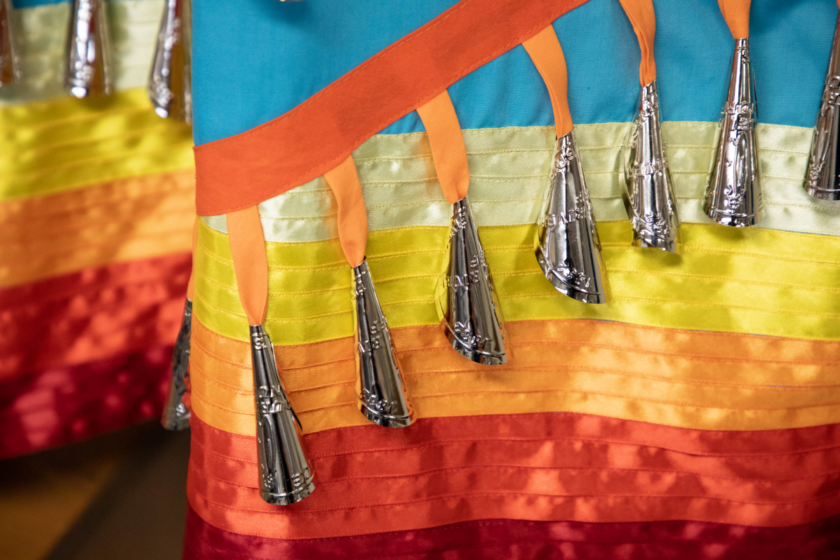
After the dress was made, the sick young girl wore the dress and her father taught her the dance he was shown in his vision. Slowly, the girl regained her strength and overcame her illness.
Comparing the timeline of this story to historical events at the time, it’s believed the young girl was infected during the Influenza Pandemic of 1918 (Spanish Flu). This pandemic had spread worldwide, and it claimed the lives of millions.
Fast-forward a little over 100 years, and there’s a new pandemic. The Coronavirus (COVID-19) pandemic that has taken the lives of millions, still threatens many people every day across the globe.
This likeness of events, although a century apart, sparked an idea at St. Joseph’s Indian School.
“People are sick and people need healing. Right now,” said Joe Tyrell, Mission Integration Director at St. Joseph’s. “It seemed like the perfect time to bring the jingle dress dance to the forefront once again.”
A Dance to Pray for the Sick
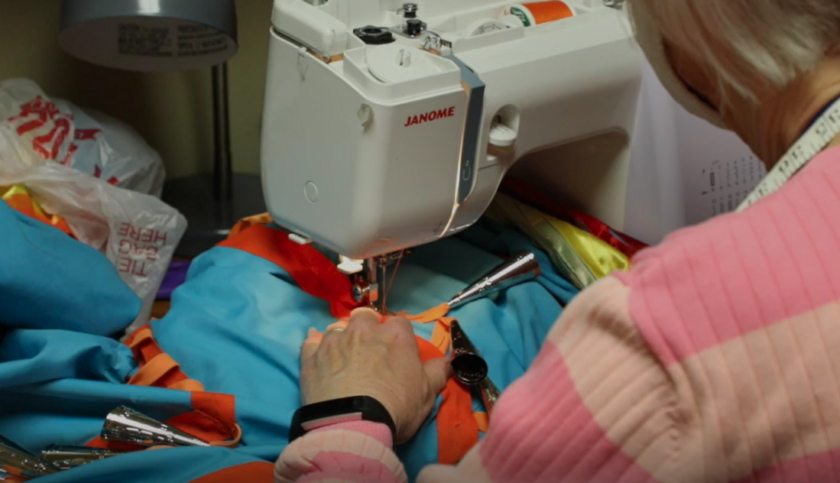
Bonnie’s hand smoothed the ripples of the light blue fabric on her sewing table. Next to it laid colored ribbons of red, orange and yellow. A long-time seamstress at St. Joseph’s, Bonnie has made many regalia items for the children to wear for powwow celebrations. But a new dress was to be fashioned for a special occasion when a group of young girls would gather together in prayer for the sick and lost.
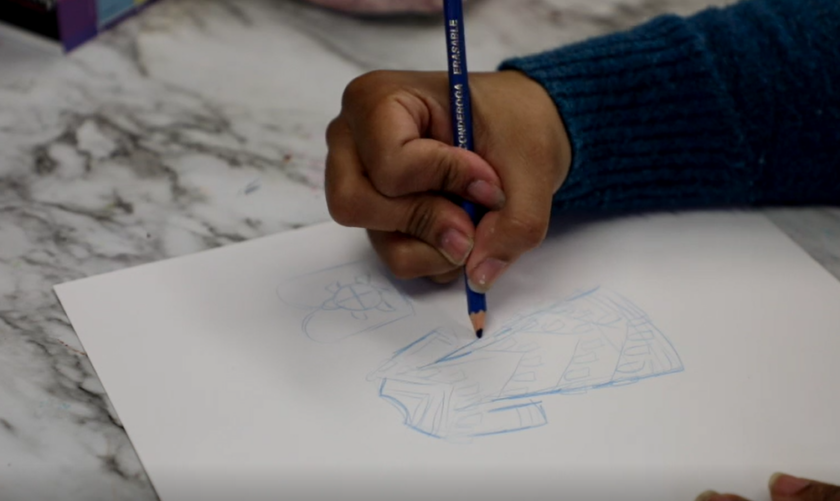
The design of the dress came from Rachel, St. Joseph’s Art teacher who is a member of the Haudenosaunee/Kanienkehaka tribe.
“Dancing jingle holds a special place for me,” said Rachel. “There were certain colors that came to mind while I designed this jingle dress. I thought of sunset colors — fire colors — so I used the red, orange and yellow. I thought of blue, like the water, because the jingle dress is a healing dress so I wanted to incorporate that into this dress.”
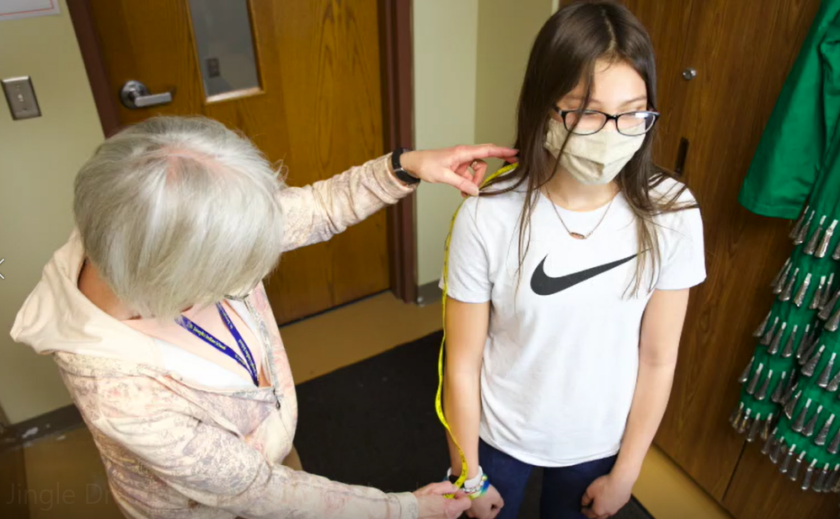
The chosen student to wear the dress was MaKaia, a sixth grade St. Joseph’s student, who was crowned Miss St. Joseph’s earlier this school year.
“I like to dance jingle,” said Makaia. “It helps me cleanse myself.”
As Bonnie got to work sewing the dress, the group of jingle dress dancers made prayer ties that would be placed inside a purse MaKaia would hold as they all danced together.
The Making of Prayer Ties and More
Making prayer ties is something very special to the Lakota (Sioux) people. As is tradition, prayer ties are made from strips of fabric and tobacco (or sage). When a prayer tie is burned, the smoke raises the prayer or the soul as it drifts toward the spirit world.
As the girls gathered around a classroom table together to make prayer ties, they said prayers inwardly in their hearts, and thought about all of the people affected during the Coronavirus (COVID-19) pandemic — not only for family, friends and community members, but also strangers.
LaRayne, St. Joseph’s Native American Studies teacher, gave each girl a piece of red fabric and sage. The girls’ hands twisted and rolled the sage into a small ball before folding it into the fabric. Their hands carefully secured the prayer tie with a red string.
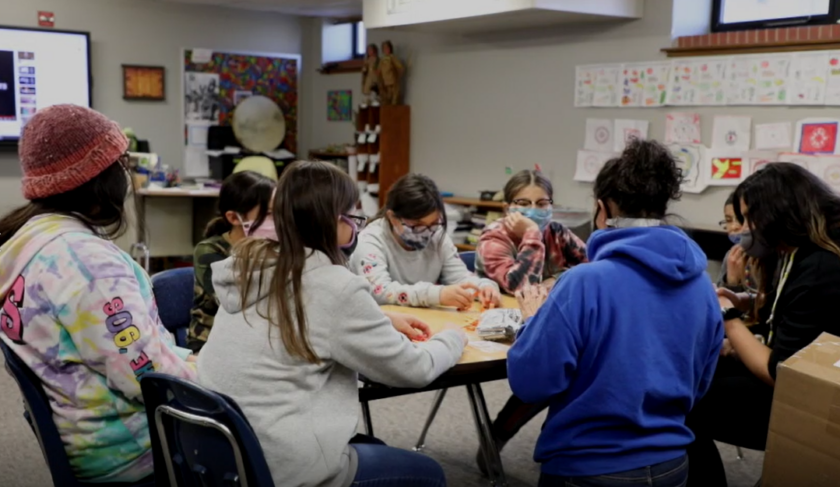
Afterward, some of the girls talked about their prayers and the people they’ve lost. Some wrote down why honoring people in this way means so much to them.
“People are sick and struggling. When I was at a low point when one of my family members passed away, it helped me know that I’m not the only one and I can help them by doing the jingle dance.”
“Dancing makes me feel like I’m dancing for everyone on Earth who is sick.”
“I dance for clear thoughts, to feel proud, happiness and to do something special.”
Despite some of this heartache and hurt, there is hope. Always hope.
“The power that comes from the dance is to heal. Any time you dance, you are dancing for someone else,” said LaRayne.
The group then came together to practice the steps in preparation for the day they’d put on their regalia together, with the prayer tie purse in tow, on a mission to help others find healing.
The Dance
A few weeks later, the day arrived.
“Are you girls ready?” asked LaRayne, smiling to the group. She and Rachel were helping the girls finish getting ready in her classroom. The room awoke with the sounds of jingles from the excited girls who wore them.
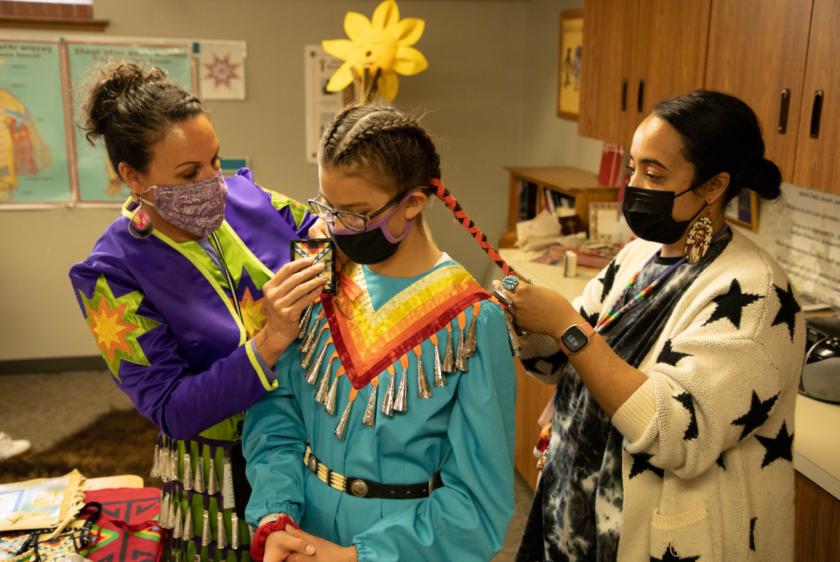
MaKaia put on the carefully made, blue dress. Her braids were wrapped with orange cloth to match the sunset palette of ribbons. Feather fluffs were also pinned into her hair to honor our winged relatives and Wakȟáŋ Tȟáŋka — the Great Spirit. Her leggings displayed the Medicine Wheel. Its circular shape represents the continuous pattern of life and death, and the path of the sun and moon as time passes.
Within the purse strung across her shoulder were the prayer ties she and the other girls had so carefully created.
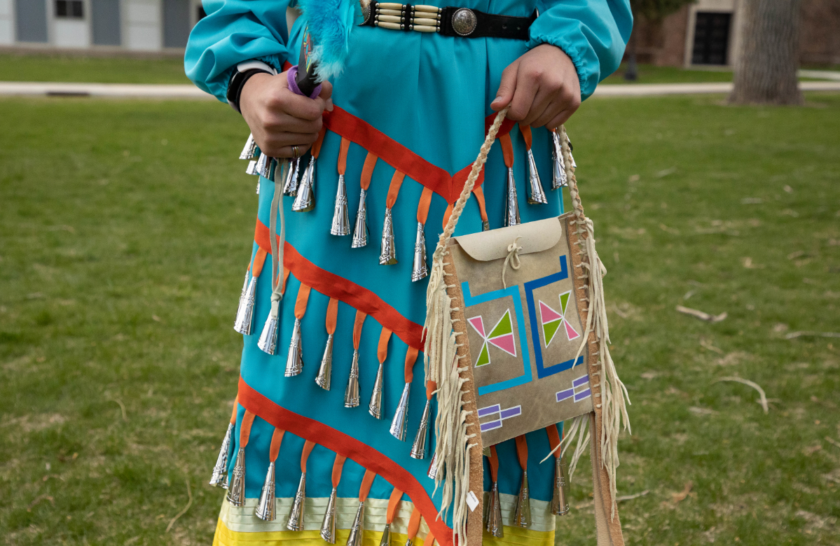
The spring weather outside was crisp and the wind held a sharpness. But, the girls were determined. They left the warmth of the indoors, jingling as they went.
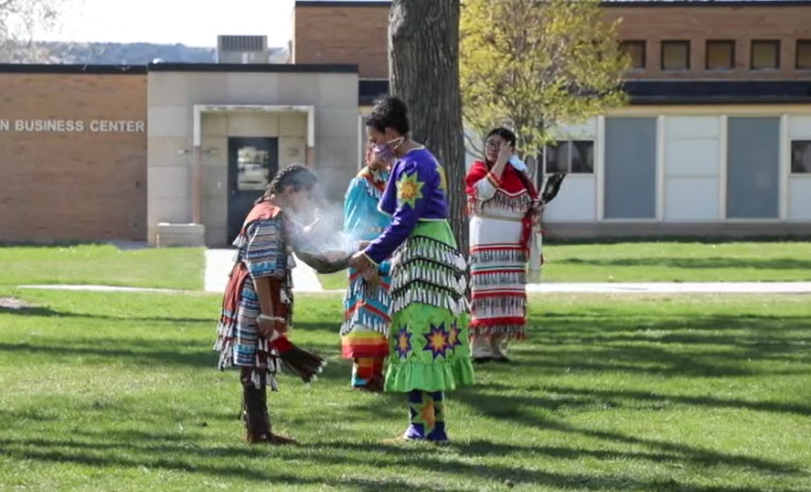
They came together in Wisdom Circle, a beautiful green space on campus in close proximity to Our Lady of the Sioux Chapel. After azílya — purification — by the act of wafting burning sage around their bodies, LaRayne spoke a prayer in Lakota. She thanked the Creator for the day, the circle of dancers and asked strength be given to the spirits of those who have died of COVID-19. She prayed for guidance and health for all as we continue moving forward.
Then, one by one, the girls started to dance. The sound of the blowing wind was soon overshadowed by the singing of jingles — a prayer not with words, but through the melody of music and dance.

For three songs the girls danced. They twirled, hopped and skipped with a purpose. Then, it seemed as simply as they began, the music stopped and a stillness came, as if to say “Amen.”
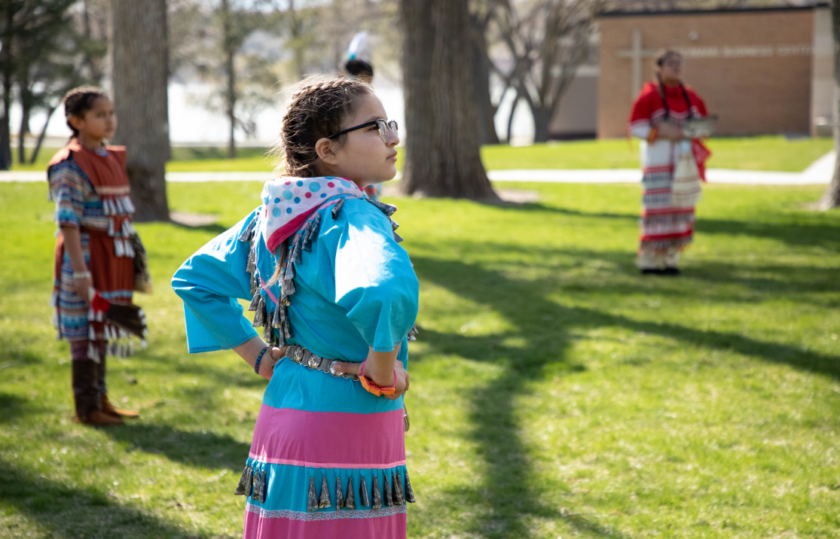
And now, as the path of the sun and moon chase one another through the cycle of another day, another week, month or year, and as events pull attention this way and that, remember that a small group of girls came together to dance. The dance was for their families, their peers, and themselves … but also for you and the world in a prayerful illustration of culture and faith joining for the common good of others.
Learn more and view a video illustration of this project by visiting www.stjo.org.


thank you. Dancing, making things for love…Nature… As you said, All together.
I just lost my younger brother on April 20 after he was moved from a hospital to a nursing home. I was his caregiver for the last three years, and also gave him one of my kidneys 15 years ago. He did not pass from COVID-19, but because of COVID, we could not visit him in the nursing home until we were told he would not live much longer. My family and I got to see him just hours before he passed. We are still grieving.
My brother always had a dream catcher hanging above his bed. I forgot to take it to him the first day he was in the hospital. After I brought it to him the next day, he said he slept better. The dream catcher went with him to the nursing home. It now hangs next to his urn. I know his dreams are peaceful now.
Thank you for your dance.
Patti, the timing of your brother’s passing — April 20 was the very same day the girls prayed with this dance! We pray his spirit was at peace as he went. Thank you for also sharing about the dreamcatcher. Your comment sharing this story has really touched our hearts.
I love the jingle dress regalia the best of all the regalia but never knew the meaning behind it. Thank you for the very informative story. I have seen 3 kinds of jingles, most are silver, some are brass (gold colored) saw and then I a girl wearing copper ones at a Pow Wow in Michigan where I live. I had never seen copper jingles before. The pictures and story of the Prayer for Healing is priceless, as these beautiful young ladies are too! Thank you for sharing the story and pictures too!
Thank you so much for this thoughtfully written article about this beautiful tradition! Such a blessing!
And I am sure many felt the blessing of the prayers these beautiful young ladies lifted up!
It is just so beautiful!, so beautiful!
I was fortunate enough to attend last September’s Pow-Wow for the first time. I will be back!! It was just terrific meeting a lot of the kids and the tours and Mass was super. It’s wonderful to see how the dresses and skirts were made. The time and effort was enormous. After meeting Father Gregg, and seeing the equestrian Blessing, I know that I will be a long term contributor and visitor in the years to come. The kids are just so sweet and nice …and determined.
God Bless all of you for what you do.